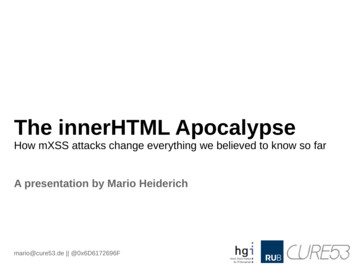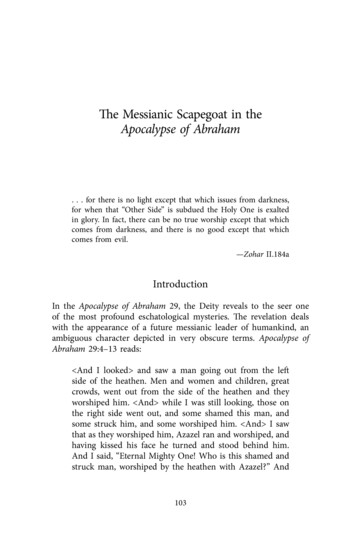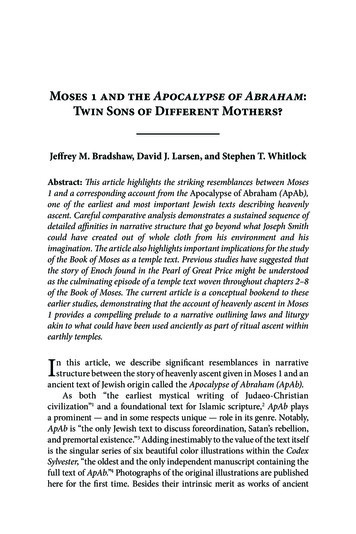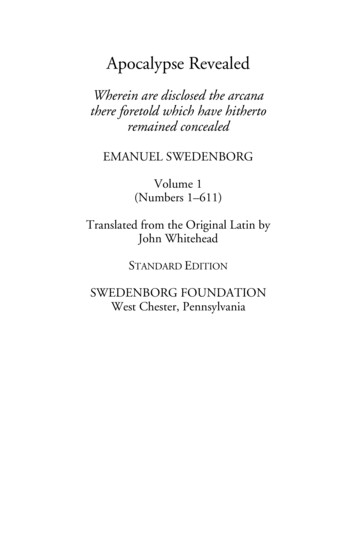
Transcription
The innerHTML ApocalypseHow mXSS attacks change everything we believed to know so farA presentation by Mario Heiderichmario@cure53.de @0x6D6172696F
Our Fellow Messenger Dr.-Ing. Mario Heiderich Researcher and Post-Doc, Ruhr-Uni Bochum– PhD Thesis on Client Side Security and DefenseFounder of Cure53–Penetration Testing Firm–Consulting, Workshops, Trainings–Simply the Best Company of the WorldPublished author and international speaker–Specialized in HTML5 and SVG Security–JavaScript, XSS and Client Side AttacksHTML5 Security Cheatsheet–@0x6D6172696F–mario@cure53.de
Research Focus Everything inside Offense HTML 2.0 – 5.1 Injection Scenarios JavaScript / JScript, VBS Active File formats Plug-ins and Controls Parser Analysis Editable Rich-Text Archeology & Legacy Porn SVG, MathML, XLS, XDR CSS, Scriptless Attacks DefenseES5 / ES6 XSS Filter / WAF / IDSDOM Clobbering CSP, DOM-based XSS FilterNo binary stuff. My braincannot :) DOM Policies DOM Trust & Control
Why? HTML on its way to ultimate power Websites and Applications Instant Messengers and Email Clients Local documentation and presentations Router Interfaces and coffee-machine UIs Medical Devices – according to this source Operating systems, Win8, Tizen HTML DOM JavaScript “I mean look at friggin' Gmail!” I measured the amount of JavaScript on 27th of Jan. 2013 It was exactly 3582,8 Kilobytes of text/javascript
Defense Several layers of defense over the years Network-based defense, IDS/IPS, WAF Server-side defense, mod security, others Client-side defense, XSS Filter, CSP, NoScript “We bypassed, they fixed.” A lot of documentation, sometimes good ones too! Hundreds of papers, talks, blog posts Those three horsemen are covered quite well!
Horsemen?Reflected XSS The White Horse – “Purity”. Easy tounderstand, detect and prevent. Stored XSS The Red Horse – “War”. Harder todetect and prevent – whererich-text of benign nature isneeded.DOMXSS The Black Horse – “Disease”.Harder to comprehend. Oftencomplex, hard to detect andprevent.
“But what's a proper apocalypse without.”
“And there before me was a pale horse! Its rider was named Death, and Hadeswas following close behind him. They were given power over a fourth of the earthto kill by sword, famine and plague, and by the wild beasts of the earth.”Revelation 6:8
“Enough with the kitsch, let's get technical”
Assumptions Reflected XSS comes via URL / Parameters We can filter input properlyPersistent XSS comes via POST / FILE We can filter output properly Tell good HTML apart from badDOMXSS comes from DOM properties No unfiltered usage of DOMXSS sources We can be more careful with DOMXSS sinks We can create safer JavaScript business logicFollowing those rules handling Uploads properly settingsome headers mitigates XSS. Right?
That telling apart. Advanced filter libraries OWASP Antisamy / XSS Filter Project HTML Purifier SafeHTML jSoup Many others out there Used in Webmailers, CMS, Social Networks Intranet, Extranet, WWW, Messenger-Tools, Mail-Clients They are the major gateway between Fancy User-generated Rich-Text And a persistent XSS Those things work VERY well! Without them working well, shit would break
“But what if we can fool those tools? Just shiparound them. Every single one of them?”
Convenience
Decades Ago. MS added a convenient DOM property It was available in Internet Explorer 4 Allowed to manipulate the DOM. without even manipulating it. but have the browser do the work!element.innerHTML Direct access to the elements HTML content Read and write of course Browser does all the nasty DOM stuff internally
Look at this// The DOM wayvar myId "spanID";var myDiv document.getElementById("myDivId");var mySpan document.createElement('span');var spanContent document.createTextNode('Bla');mySpan.id endChild(mySpan);// The innerHTML wayvar myId "spanID";var myDiv document.getElementById("myDivId");myDiv.innerHTML ' span id "' myId '" Bla /span ';
Compared Pro Contra It's easy It's fast It's now a standard It just worksIt's got a bigbrother. outerHTML Bit bitchy with tablesSlow on olderbrowsersNo XMLNot as “true” as realDOM manipulation
Who uses it?
Rich Text Editors The basically exist because of innerHTML And of course contentEditable And they are everywhere CMS Webmailers Email Clients Publishing Tools
“Now, what's the problem with all this?”
Internals We might be naïve and assume: ƒ(ƒ(x)) ƒ(x) Idempotency An elements innerHTML matches it's actual contentBut it doesn't It's non-idempotent and changes!And that's usually even very good! Performance Bad markup that messes up structure Illegal markup in a sane DOM tree
Examples We have a little test-suite for you Let's see some examples And why non-idempotency is actually goodIN: div 123OUT: div 123 /div IN: Div/class abc 123OUT: div class "abc" 123 /div IN: span dIV 123 /span OUT: span div 123 /div /span
Funny Stuff So browsers change the markup Sanitize, beautify, optimize There's nothing we can do about it And it often helps Some funny artifacts exist. Comments for instance Or try CDATA sections for a change.IN: !- OUT: !----- IN: !-- OUT: !---- IN: ![CDATA] OUT: !--[CDATA]--
“And what does it have to dowith security again?”
It was back in 2006. . when a fellow desk-worker noticed astrange thing. Magical, even!
The Broken Preview Sometimes print preview was bricked Attribute content bled into the document No obvious reason. Then Yosuke Hasegawa analyzed the problem One year later in 2007 And discovered the first pointer to mXSS
Now let's have a look DEMO Requires IE8 or older
IN: img src "foo" alt " onerror alert(1)" / OUT: IMG alt onerror alert(1) src "x"
Pretty bad But not new Still, works like a charm! Update: A patch is on the way! Update II: Patch is out! But not new Did you like it though? Because we have “new” :)
Unknown Elements Again, we open our test suite Requires IE9 or older Two variations – one of which is new The other discovered by LeverOne
IN: article xmlns " img src x onerror alert(1)" /article OUT: ?XML:NAMESPACE PREFIX [default] img src xonerror alert(1) NS " img src x onerror alert(1)"/ article xmlns " img src x onerror alert(1)" /article
IN: article xmlns "x:img src xonerror alert(1) " OUT: img src x onerror alert(1):article xmlns "x:img src xonerror alert(1) " /img src xonerror alert(1) :article
Not Entirely Bad Few websites allow xmlns Everybody allows (or will allow) article though Harmless HTML5 Alas it's a HTML4 browser – as is IE in older documentmodes Wait, what are those again? meta http-equiv "X-UA-Compatible" content "IE IE5" / Force the browser to fall-back to an old mode Old features, old layout bugs. And more stuff to do with mutations
“Now for some real bad things!”
Style Attributes Everybody loves them It's just CSS, right? XSS filters tolerate them But watch their content closely! No CSS expressions No behaviors (HTC) or “scriptlets” (SCT) Not even absolute positioning. .or negative margins, bloaty borders
Let's have a look And use our test suite again All IE versions, older Firefox
IN: p style "font-family:'\22\3bx:expression(alert(1))/*'" OUT: P style "FONT-FAMILY: ; x: expression(alert(1))" /P
“And there's so many variations!”And those are just for you, fellow conference attendees,they are not gonna be on the slidesSo enjoy!
HTML Entities Chrome messed up with textarea Found and reported by EduardoFirefox screwed up with SVG svg style <img src x onerror alert(1)> /svg IE has problems with listing listing <img src x onerror alert(1)> /listing Let's have another look again and demo. Also.text/xhtml! All CDATA will be decoded! That's also why inline SVG and MathML add more fun
Who is affected? Most existing HTML filters and sanitizers Thus the software they aim to protect HTML Purifier, funny, right? JSoup, AntiSamy, HTMLawed, you name it! Google Caja (not anymore since very recently) All tested Rich-Text Editors Most existing Web-Mailers This includes the big ones As well as open source tools and librariesBasically anything that obeys standards. . and doesn't know about the problem
Wait. it's encoded! pstyle p;#x65;ession(alert(1))'" Yep. Encoded. But does it matter?
Wait. it's encoded! pstyle p;#x65;ession(alert(1))'" Yep. Encoded. But does it matter?NO!mXSS mutations work recursively!Just access innerHTML twice! For your health!
How to Protect? Fancy Websites Enforce standards modeAvoid getting framed, useXFO !doctype html Use CSP Actual Websites Patch your filter! Employ strict white-lists Motivate users to upgradebrowsersAvoid SVG and MathMLAvoid critical characters inHTML attribute valuesBe extremely paranoid aboutuser-generated CSS Don't obey to standards Know the vulnerabilitiesAnd for Pentesters?Inject style attributes backslash or ampersand andyou have already won.Nothing goes? Use the back-tick trick.
Alternatives mXSS Attacks rely on mutations Those we can mitigate in the DOM Behold. TrueHTML Here's a small demo We intercept any innerHTML access And serialize the markup. XML-style Mitigates a large quantity of attack vectors Not all though Know thy CDATA sections Avoid SVG whenever possible Inline-SVG is the devil :) And MathML isn't much better.
Takeaway? So, what was in it for you? Pentester: New wildcard-bug pattern Developer: Infos to protect your app Browser: Pointer to a problem-zone to watch Specifier: Some hints for upcoming specs
Wrapping it up Today we saw Some HTML, DOM and browser history Some old yet unknown attacks revisited Some very fresh attacks A “pentest joker” Some guidelines on how to defend The W3C's silver bullet. For 2015 maybe.
The End Questions? Comments? Can I have a drink now? Credits to Gareth Heyes, Yosuke Hasegawa, LeverOne, Eduardo Vela, Dave Ross, Stefano Di Paola
Defense Several layers of defense over the years Network-based defense, IDS/IPS, WAF Server-side defense, mod_security, others Client-side defense, XSS Filter, CSP, NoScript "We bypassed, they fixed." A lot of documentation, sometimes good ones too! Hundreds of papers, talks, blog posts Those three horsemen are covered quite well!



![[HACK INSTA] Using Our Website In 1 Minutes 1O@5-aS! - UT Southwestern](/img/65/hack-instagram-account-mdx12.jpg)






